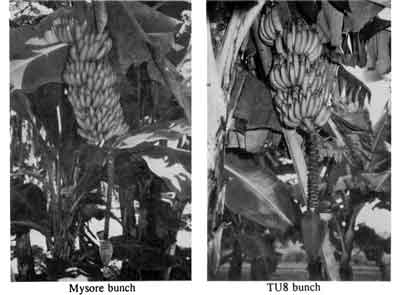
DISEASE RESISTANT BANANA VARIETIES FOR BACKYARDS
SCIENTIFIC NAME: Musa species
FAMILY: Musaceae
Banana diseases particularly leaf spot (Mycosphaerella musicola) and Panama disease (Fusarial wilt, Fusarium oxysporum f. sp. cubense) are major problems facing the production of bananas on commercial farms in Queensland. These diseases also affect bananas grown in many backyards. As part of the Banana Industry Protection Board's program to control these diseases, two new varieties are to be made available for householders. Mysore and TU8, both of which are dessert-type bananas, will not require regular chemical sprays. Both varieties produce good bunches and do so with minimal infection by leaf diseases. It is only the lower 1 or 2 leaves which may become infected, so these should be removed periodically to assist in the control of disease.

Mysore bunches are cylindrical with tightly-packed, short, plump, bottle-neck fruit. The flesh is agreeably sweet-acid and has a satisfactory shelf life. The bunch weight of Mysore is usually in the range of 15 to 25 kg, and plant height (to top of bunch) of 3 to 4.5 m. Mysore is easily recognized by the pinkish-purple midribs and purple-bronze flush on the underside of newly-emerging leaves. Mysore is the most popular variety in India and is common in the Pacific Islands.
TU8 is a product of the banana breeding program in Jamaica. It is otherwise known under the codes T8 (Cook Islands) and 61-882 (Jamaica). The fruit superficially resembles the Cavendish varieties in shape and taste, although it did not rate quite as highly in a taste panel assessment, partly because of its softer texture. The bunch weight of TU8 is usually in the range of 20-30 kg and plant height of 2.5 to 4 m. TU8 can be distinguished from Cavendish varieties with its droopier leaf habit and a characteristic twist in the tip of the leaf.
Mysore and TU8 also have good resistance to the serious leaf disease, black Sigatoka (Mycosphaerella fijiensis), present on our doorstep in the Torres Strait. Both are also resistant to the soil-borne fungus causing Panama disease Race 1. Additionally, Mysore is resistant to Panama disease Race 4 attacking Cavendish type bananas in southern Queensland.
Tissue cultured plants in pots will be available for purchase early in 1992. Planting permits and further information are available from the Innisfail QDPI office.
DATE: November 1991
* * * * * * * * * * * * *
